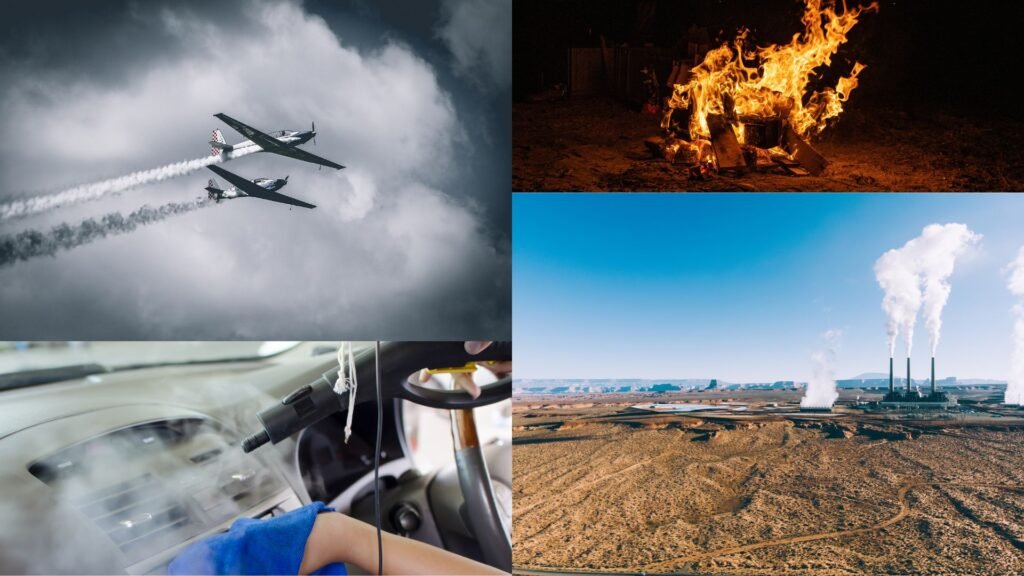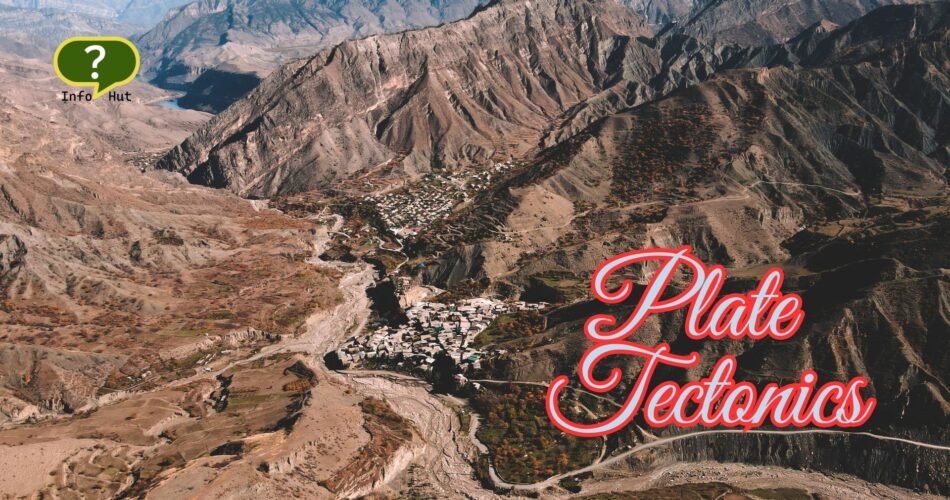This blog is a detailed explanation of the Role of Plate Tectonics in the Climate Change. It includes the introduction to plate tectonics, Continental Drifts, Mountain Building and Atmospheric Circulations, Volcanic Activity and Greenhouse gases, Ocean Basins and Heat Distribution, Impact on Weather patterns and Connections of Climate and Plate Tectonics in detail.
What Are Plate Tectonics?
The lithosphere is divided into major plates like the Pacific, Eurasian, and North American plates, and smaller plates such as the Nazca and Philippine plates. These plates move due to forces generated within the Earth, including:
Mantle Convection:
Heat from the Earth’s core drives circular currents in the mantle that push and pull plates. This is the phenomena by which excessive heat is extracted from the Earth’s interior by ascending hot and also descending cold currents in the mantle. It contributes in chemical mixing in the Earth’ interior.
Ridge Push:
At mid-ocean ridges, gravity causes newly formed, elevated crust to slide away, moving plates apart. It is the driving force for plate motion in plate tectonics. It is caused by the gravitational pull of the Earth so this results in movement of Oceanic Plate to move away from a mid-ocean ridge.
Slab Pull:
Dense oceanic plates sink into the mantle at subduction zones, pulling the rest of the plate along. In this the oceanic plates sinks deep down under the less dense Continental Plates. It is a Geophysical Mechanism that is driven by changes into the Earth’s interior.
These explain the possible movements of plates that shades the Earth’s climate system. This blog contains information about Plate Tectonics and Climate Change.

How Plate Tectonics Shapes the Climate
Over millions of years, the movement of tectonic plates alters the configuration of continents, oceans, and mountains. These changes directly impact global climate by influencing the circulation of air and water, as well as the distribution of heat.
Continental Drift and Climate Change
Continental drifts play a very significant role in maintaining and formation of the Climate. These drifts may have extreme impacts and results on the Climate. The slow movement of continents, known as continental drift, changes the planet’s climate in the following ways:
Position of Continents:
As the continents move in the direction the poles, they face lower temperatures, leading to formation of glaciers. For example, current icy environment of Antarctica started when it travelled to its polar region. Contrarily, the continents that are near the equator experience higher temperatures.
Ocean Circulation:
Ocean Circulation is the process of travelling of waves with a certain pattern that is formed Naturally by winds. The breakup or joining of continents reshapes ocean currents. For example, the separation of South America and Africa created the Atlantic Ocean and altered global heat distribution.
This blog contains information about Plate Tectonics and Climate Change.
Mountain Building and Atmospheric Circulation:
When tectonic plates collide, they form mountain ranges that profoundly influence weather and climate:
Rain Shadows:
The rain shadow is defined as the land that lies on the leeward side of a mountain. This area is recognized by significantly reduced rainfall because wind carries the air masses upwards over the mountain range. This region is away from the prevailing winds and so rainfall is less.
Global Wind Patterns:
Huge mountain ranges disturb the circulation mechanism of atmosphere, guiding the jet streams and also controlling the system of monsoon. In South America, Andes shapes weather, at present. These are extremely important in maintaining Earth’s Climate and Weather Patterns.
This blog contains information about Plate Tectonics and Climate Change.
Volcanic Activity and Greenhouse Gases
Volcanic Activities are collectively called as Volcanism. Complete Volcanism directly associates with Plate Tectonics. Volcanic eruptions, a direct result of plate tectonics, release gases and also the particles into the atmosphere:
Short-Term Cooling:
This is temporary cooling in the Climatic Conditions by different Natural Activities on Earth. Large-scale emissions release SO2, creating aerosols that block sunlight and so cools the planet for sometime. Mount Tambora had an eruption in 1815 that made the “Year Without a Summer.”
Long-Term Warming:
Over geologic timescales, volcanic eruptions release carbon dioxide, a greenhouse gas that contributes to warming. This long-term release has influenced past climates, such as the warming period following the formation of the Siberian Traps.
This blog contains information about Plate Tectonics and Climate Change.
Ocean Basins and Heat Distribution
Ocean Basins and Heat distribution play integral roles in the maintenance of the Climate and also Weather patterns. Plate tectonics controls the formation of ocean basins and the pathways of currents that regulate the Earth’s temperature:
Thermohaline Circulation:
Deep ocean currents, driven by differences in temperature and salinity, and so distribute heat globally. Changes in plate positions can redirect these currents, impacting global climate systems. This phenomena is very important in maintaining Climatic conditions on Earth.
The Closing and Opening of Waterways:
Events like the closure of the Isthmus of Panama millions of years ago altered ocean currents, strengthening the Gulf Stream and influencing European climates. This also worked for facilitating plants and animals from one continent to another.
These are the phenomena that contributes in Climate Formation. This blog contains information about Plate Tectonics and Climate Change.
Deep Carbon-cycle and Plate Tectonics:
Deep Carbon-cycle is defined as the system that connects the exospheric (Atmosphere, Hydrosphere, Biosphere) Carbon dioxide to the carbon reservoirs in Earth’s mantle and crust. It is a very important natural phenomena that influence many other natural geological systems on Earth.
Plate tectonics is the most important driver of deep carbon-cycle as it helps in transferring of carbon between the Earth surface and its interior because of its constant movement. Oceanic plates are responsible to transfer or move carbonates and sediments to other plates and CO2 is degassed from the mid-ocean ridges to the volcanic arcs. Following are the steps that describes how plate tectonics drives Carbon-cycle:
1. Subduction
Oceanic plates carries marine sediments and carbonates and pull down in the subduction zone to transfer carbon to the Earth’s Interior.
2. Mantle Transport
The subduction plates are responsible to transfer this carbon into the mantle of the Earth. There it turns into mantle rocks and also make carbonate minerals.
3. Outgassing and Volcanism
At the mid-ocean ridges, carbon is outgassed into the atmosphere and ocean from the interior of the earth using Volcanic Eruptions.
In this way Plate Tectonics influences Deep-carbon cycle and also involves in shaping the Climate of the Earth.
Impact on Weather Patterns and Case Studies
While plate tectonics primarily affects climate over millions of years, it can also influence weather events in more immediate and dramatic ways.
Earthquakes and Tsunamis
Tectonic activity causes earthquakes, which can trigger tsunamis. These massive waves disrupt coastal weather systems and also devastate human settlements.
Case Study of Earthquakes and Tsunamis:
The 2004 Indian Ocean earthquake and tsunami significantly affected coastal weather and environmental conditions.
Volcanic Eruptions and Weather
Large eruptions inject ash and gases into the atmosphere, altering weather patterns. The aerosols from volcanic eruptions can cause “volcanic winters” by cooling the surface temporarily.
Case Study of Volcanic Eruptions and Weather:
The 1991 eruption of Mount Pinatubo reduced global temperatures by about 0.6°C for nearly two years.
This blog contains information about Plate Tectonics and Climate Change.
Case Studies on Tectonic-driven Climate Shifts:
Climate Connections means the connections and interactions that forms and maintains Climate on Earth. Following are some of the Climate Connections mentioned below:
The Himalayas and the Asian Monsoon
The collision between the Indian and Eurasian plates formed the Himalayas, which play a critical role in the Asian monsoon system. These towering mountains block warm, moist air from the Indian Ocean, forcing it to rise and so condense into heavy rains, driving the monsoon cycle that supports agriculture in South Asia.
The Opening of the Atlantic Ocean
The divergence of the African and South American plates created the Atlantic Ocean, altering global ocean currents and establishing the Gulf Stream. This warm current moderates the climate of Western Europe, making it significantly warmer than other regions at similar latitudes.
The End of the Ice Age
Changes in plate tectonics, such as the shifting of continents and volcanic activity, contributed to the end of the last Ice Age. The breakup of landmasses and the rise of greenhouse gases from volcanic activity warmed the planet, leading to the retreat of glaciers.
This blog contains information about Plate Tectonics and Climate Change.
Long-Term Implications of Plate Tectonics on Climate
Plate Tectonics not only cast short-term and abrupt impacts on Climate, but it is also cause of many Long-term Climatic Impacts. Plate tectonics is an ongoing process, and also its impact on climate will continue to shape the Earth’s future:
Supercontinents and Ice Ages:
Supercontinents are the continents that makes up most of the land of the Earth. While Ice age is the period in which Earth was frozen for many years. The formation and breakup of supercontinents, such as Pangaea, drastically alter climate patterns by reshaping ocean and atmospheric circulation.
Future Climate Shifts:
Plate tectonics is also responsible for future Climate Shifts and Future Weather Patterns. As tectonic plates move, new mountain ranges will rise, ocean currents will shift, and so climates will change, potentially creating new habitats or driving mass extinctions.
This blog contains information about Plate Tectonics and Climate Change.
Three times Plate Tectonics Shaped Climate
Snowball Earth:
The amount of carbon dioxide regulates by the exposure of weathering of silicate rocks on Earth. When the calcium silicates are mixes with water, it form Calcium carbonate. This results in carbon sequestration and at extreme, no CO2 in the atmosphere. It declined global Greenhouse Effect and the Earth was turned into a Snowball. This occurred because of Continent Shifting and Climate of Snowball Earth.
Kick-starting the South-Asian Monsoon:
Tibetan Plateau is the largest and highest Plateau in the world. Sun heats this plateau throughout the summer and so it creates upwards convection currents that captures air from the surrounding areas. This cause monsoon over Southeast Asia. Tibetan Plateau is the major trigger of monsoon rains in Southeast Asian Region. Scientists are still identifying the link and distinctiveness between the roles of uplift, sea-land distribution and Global Cooling.
Rocking Humanity’s Cradle:
This statement depicts the fact that sometimes the Plate Tectonics can also be the cause of abrupt changing in the world’s climatic conditions. First and most important example is Ice Age, in which the Earth was rapidly froze and led to great destruction to life. Another example includes the rapid changes in Climate in eastern and southern Africa 7 million years ago. This contributed in evolution and dispersion of our human ancestors.
Conclusion
The mechanism Plate tectonics is not just a geological process; it is the most prominent driver of Climate of the earth and its weather patterns. From the creation of mountains that effects rainfall patterns to changing ocean currents that maintains global temperatures, so as the tectonic plates movement settles the environment in intense ways. Witnessing these relations is necessary for promoting the composite role between the atmosphere and the Earth’s surface. This may guide up in getting ready for the hurdles of natural disasters and extended climate change.
The energetic nature of the Earth that is driven by plate tectonics, highlights the complex and interrelated systems that make living possible in the world. By learning this fact, we gain useful overview into the past, present, and future of our continuously changing world. This blog contains information about Plate Tectonics and Climate Change.

To learn about more topics, Click the links below:


Comments